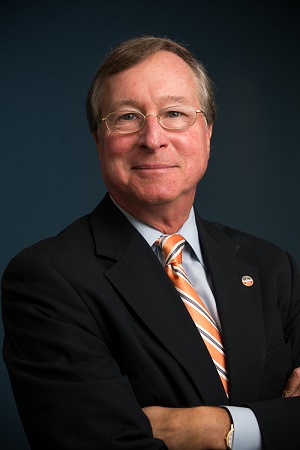 Since 1998, Ed Hamberger has served as president and chief executive officer of the Association of American Railroads (AAR), the world’s leading railroad policy, research and standard setting organization for freight railroads of the United States, Canada and Mexico, as well as Amtrak.
Since 1998, Ed Hamberger has served as president and chief executive officer of the Association of American Railroads (AAR), the world’s leading railroad policy, research and standard setting organization for freight railroads of the United States, Canada and Mexico, as well as Amtrak.
With more than forty years of combined experience in private legal practice and the legislative and executive branches of the United States government, Hamberger, considered one of Washington’s most-effective transportation policy advocates, works with member railroads to ensure the continued viability of America’s railroad industry.
Hamberger began his career in transportation as general counsel of the National Transportation Policy Study Commission. He subsequently served as assistant secretary for governmental affairs at the U.S. Department of Transportation and managing partner at Baker, Donelson, Bearman & Caldwell in Washington, DC.
Hamberger has also served as an appointed member of the Private Sector Advisory Panel on Infrastructure Financing and as a member of the Presidential Commission on Intermodal Transportation. Most recently, he served on the Blue Ribbon Panel of Transportation Experts, after being appointed by the National Surface Transportation Policy and Revenue Study Commission.
Understanding Our Freight Systems
There is an incredible need to educate. One of the big frustrations in our freight rail industry is that people do not appreciate the importance of freight and don’t realize that we are—along with the trucking industry and along with the barge and towing industry—critical to the nation’s economy. People just seem to think about freight railroads when they’re sitting, watching it go by, and being frustrated that the gate is down at a grade crossing. It is, from a public policy standpoint, critical that Congress and the Administration will recognize the importance of freight.
Private Investment Makes Freight Rail Work
From just the freight railroads standpoint, we do not get any federal money, or very, very little in the form of public-private partnerships. There is no subsidy; there is no railroad trust fund. We maintain and upgrade our infrastructure with private money. That’s why we got the “B” from the American Society of Civil Engineers versus all the other infrastructure systems. We are not in a crisis; we are, in fact, providing some of the best service ever and 2016, I’m really, really pleased to say, was our safest year on record in terms of accident rate.
Getting on Board With User Fees
The Highway Trust Fund, when it was established in the 50s, started out as 4 cents a gallon. The last time it was increased—it is now 18 cents a gallon—was in the early 1990s. A lot has happened in the world since then, including inflation, and there just seems to be a lack of understanding that Americans are willing to pay for an increase in their efficiency and safety…Secretary Elaine Chao at the Department of Transportation has said that there would be a major infrastructure piece of legislation coming out of the Administration in May. But the big question is: how is it going to be paid for?
The Association of American Railroads: Who We Are
A DOT study indicated that every American consumes 54 tons of freight per year, and that has to get to you and me in an efficient, safe way. Railroads move 40% of that freight on an inter-city basis, based on ton-miles…The AAR is the Association of American Railroads and its mission began 80 years ago when the operators of the railroads realized that they needed standards for the rail cars and the locomotives to go from one railroad to another, not only just for efficiency but also for safety, so that’s how we began. We still have that as a primary function, but it has evolved over the years to also be a government relations, regulatory affairs, public affairs focus as well.
Download full transcript (PDF): Edward Hamberger on The Infra Blog
Tags: AAR, American Association of Railroads, Edward Hamberger, Freight, Freight Rail






 RSS Feed
RSS Feed